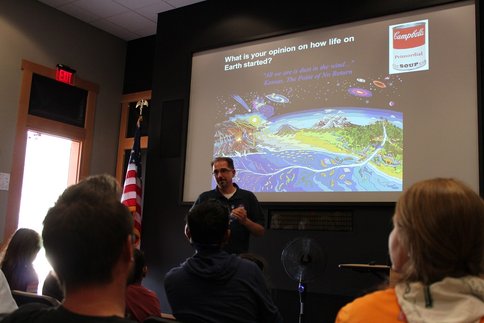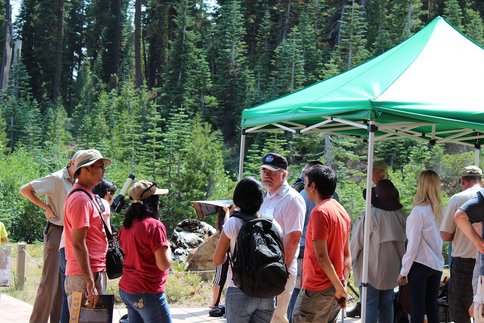2015 Annual Science Report
 NASA Ames Research Center
Reporting | JAN 2015 – DEC 2015
NASA Ames Research Center
Reporting | JAN 2015 – DEC 2015
NAI ARC Communications
Project Summary
The ARC NAI Team interacts with a number of institutions that fall outside the NAI proper. These include universities and other domestic and international organizations, chief of which are Langston University, the Chickasaw and Choctaw Nations, and the Dutch Astrochemistry Network, which is part of the Netherlands Organization for Scientific Research (NWO).
Project Progress
Our team’s “Support for Other Institutions” module consisted of four primary activities this past year; supporting the growing Astrochemistry subdivision of the American Chemical Society (ACS), supporting the Chickasaw and Choctaw Native American tribes in their summer science camps and related activities, hosting student summer interns from Langston University, Langston, OK, and collaborating with the Dutch Astrochemistry Network (DAN).
The team’s support for the Astrochemistry subdivision of the American Chemical Society (ACS) included team member Dr. Timothy J. Lee serving as the Chair-Elect of the Astrochemistry subdivision for 2015. Team members Drs. Timothy Lee and Louis Allamandola organized an Astrochemistry session “Carbon in the Galaxy the Formation of Complex Organics from the Outflow of Carbon Stars & their Evolution” for the 249th National ACS Meeting in Denver, CO, March 2015. Several talks at that session were given by ARC team members Partha Bera, Timothy Lee, Scott Sandford, Christopher Materese, and by DAN (Dutch Astrochemistry Network) collaborators Xander Tielens and Harold Linnartz.
Ames entire NAI team worked on developing hands on science activities for Native American youth and on June 9th and 10th, Dr. Andrew Mattioda, of the NASA Ames NAI (NASA Astrobiology Institute) CAN 7 team, participated in the Chickasaw Nation Aeronautics and Space Academy (CNASA), held in Ada, OK. The Chickasaw Nation conducts the week-long camp to encourage their youth to consider careers in science and technology. During his two days at the camp, Dr. Mattioda talked to the students about NASA career opportunities as well as conducted hands-on science demonstrations about infrared light and spectroscopy with the eighteen 8th to 12th grade students present. With the help of Dr. Carl Rutledge, East Central University, Ada, OK, the students were able to view Venus, Jupiter, and Saturn and, during the day, solar prominences and sun spots. One of the Chickasaw students could not believe a person from NASA came all the way just for them. She kept asking “Why are you really here?” Another student, excited by his NAI grab bag, exclaimed, “If I end up developing faster than light travel it is because you were here today and gave us all of this!” This statement highlights the impact our Support for Other Institutions module has on students.
Team members Drs. Michel Nuevo and Andrew Mattioda took the group’s hands-on science demonstrations to the Choctaw Nation Summer Camp, held in Hartshorne, OK. This was only the second year of the camp designed to encourage the Choctaw youth to pursue careers in the science and engineering fields. During their two days (July 21st and 22nd) at the two weeklong camp, Drs. Mattioda and Nuevo talked to the students about NASA career opportunities as well as conducted the hands-on science demonstrations bout infrared light and spectroscopy with the twenty one 8th to 12th grade students present and showed them how to build a comet (Figure 1).
Another major area of the ARC Team’s Support for Other Institutions has been our involvement with Langston University, Langston, OK. Langston University (LU) is the furthest West HBCU (Historically Black College or University) in the United States. In 2015 our team hosted several tours of NASA Ames Research Center for LU undergraduate students. An outcome of these tours has been the development of our LU summer internship program. Three LU students are selected to come to Ames for an 8 week summer internship. In 2015 we worked out the specifics of the application process, housing, etc., and we hosted our first summer undergraduate internships students – Halina Garraway, Danielle Wright, and Nicholas Davis (Figure 2). The interns worked on our NAI projects and presented posters of their progress at the end of the summer.
Our team also supported summer a MUREP (Minority University Research and Education Program) undergraduate intern, Frank Contreras, a San Jose State University Materials Engineering major, for a 10 week internship in the Astrochemistry Laboratory under the mentorship of Dr. Andrew Mattioda. Mr. Contreras summer internship opened up the door for him to an intern in the NASA Ames Materials Engineering Branch.
Drs. Scott Sandford and Andrew Mattioda supported NASA’s Astrobiology Institute’s public outreach efforts during the Lassen Volcanic Dark Sky Festival, August 7-9, 2015, at Lassen Volcanic Park. Dr. Mattioda gave a public lecture entitled “Astrochemistry: The Chemistry of the Stars.” Dr. Sandford gave public lecture entitled “Just How Common is Life in the Universe?” and “The Power of Comet and Asteroid Samples.” The Lassen Dark Sky Festival provides the public the opportunity to star gaze with astronomers, listen to, and chat with space scientists, and all three talks were given to packed crowds (see Figures 3 and 4).
The first offering of the Fall School of Astrochemistry on the West Coast was organized by NAI ARC team members Partha Bera, Michel Nuevo, and Chris Materese and held at the SETI Institute in Mountain View, California on 13-16th October 2015. The school consisted of eight lectures given by Prof. Alexander Tielens (Leiden University, NL, NAI ARC Collaborator, and DAN member) on various aspects of astrochemistry. These lectures were designed for younger scientists such as graduate students, post docs, and researchers who work in the broad area of astrochemistry. The school provided a forum for in-depth discussions on topics that were driven by the participants, who also presented their work in the form of lightning talks. In addition to the lectures given by Prof. Xander Tielens, individual lectures were given by Dr. Lou Allamandola (Collaborator), Dr. Timothy Lee (Co-I), Dr. Scott Sandford (PI), Dr. Farid Salama, and Dr. Andy Mattioda (Co-I) on special interest topics. The school was attended by 23 students, postdocs, and scientists from institutions in the San Francisco Bay Area. Further details about the school can be found on the web at: https://fallschoolofastrochem.wordpress.com.
Finally, the ARC NAI Team is in the process of arranging a Non Reimbursable Space Act Agreement with the Dutch Astrochemistry Network, which is part of the Netherlands Organization for Scientific Research (NWO). The intent of this potential partnership is to pursue research on the origin and evolution of molecules in space and their role in the Universe, in particular in regions of star and planet formation. As part of the arrangement, the two groups would formalize collaborative work they are already doing together on specific scientific issues. The two groups participate in joint telecons and meet annually through site visits either at NASA ARC, Leiden University or at other DAN-II subnodes in The Netherlands, or as part of other scientific conferences. The 2015 annual meeting between the groups was held during the ACS meeting held in March in Denver, CO.
-
PROJECT INVESTIGATORS:
-
PROJECT MEMBERS:
Partha Bera
Co-Investigator
Uma Gorti
Co-Investigator
Martin Head-Gordon
Co-Investigator
Gregory Laughlin
Co-Investigator
Timothy Lee
Co-Investigator
Andrew Mattioda
Co-Investigator
Louis Allamandola
Collaborator
Christiaan Boersma
Collaborator
Xander Tielens
Collaborator
Gustavo Cruz-Diaz
Research Staff
Christopher Materese
Research Staff
Michel Nuevo
Research Staff
-
RELATED OBJECTIVES:
Objective 3.1
Sources of prebiotic materials and catalysts
Objective 3.2
Origins and evolution of functional biomolecules
Objective 3.4
Origins of cellularity and protobiological systems




